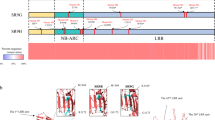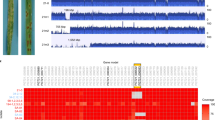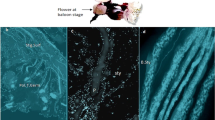Abstract
Accumulation of genetic incompatibilities within species can lead to reproductive isolation and, potentially, speciation. In this study, we show that allelic variation at SRF3 (Strubbelig Receptor Family 3), encoding a receptor-like kinase, conditions the occurrence of incompatibility between Arabidopsis thaliana accessions. The geographical distribution of SRF3 alleles reveals that allelic forms causing epistatic incompatibility with a Landsberg erecta allele at the RPP1 resistance locus are present in A. thaliana accessions in central Asia. Incompatible SRF3 alleles condition for an enhanced early immune response to pathogens as compared to the resistance-dampening effect of compatible SRF3 forms in isogenic backgrounds. Variation in disease susceptibility suggests a basis for the molecular patterns of a recent selective sweep detected at the SRF3 locus in central Asian populations.
This is a preview of subscription content, access via your institution
Access options
Subscribe to this journal
Receive 12 print issues and online access
$209.00 per year
only $17.42 per issue
Buy this article
- Purchase on Springer Link
- Instant access to full article PDF
Prices may be subject to local taxes which are calculated during checkout




Similar content being viewed by others
References
Rieseberg, L.H. & Willis, J.H. Plant speciation. Science 317, 910–914 (2007).
Bomblies, K. Doomed lovers: mechanisms of isolation and incompatibility in plants. Annu. Rev. Plant Biol. 61, 109–124 (2010).
Dobzhansky, T. Genetics and the Origin of Species (Columbia University Press, New York, 1937).
Muller, H. Isolating mechanisms, evolution, and temperature. Biol. Symp. 6, 71–124 (1942).
Bomblies, K. & Weigel, D. Arabidopsis and relatives as models for the study of genetic and genomic incompatibilities. Philos. Trans. R. Soc. Lond. B. Biol. Sci. 365, 1815–1823 (2010).
Alcázar, R., García, A.V., Parker, J.E. & Reymond, M. Incremental steps toward incompatibility revealed by Arabidopsis epistatic interactions modulating salicylic acid pathway activation. Proc. Natl. Acad. Sci. USA 106, 334–339 (2009).
Bikard, D. et al. Divergent evolution of duplicate genes leads to genetic incompatibilities within A. thaliana. Science 323, 623–626 (2009).
Bomblies, K. et al. Autoimmune response as a mechanism for a Dobzhansky-Muller-type incompatibility syndrome in plants. PLoS Biol. 5, e236 (2007); comment 5, e262 (2007).
Eyüboglu, B. et al. Molecular characterisation of the STRUBBELIG-RECEPTOR FAMILY of genes encoding putative leucine-rich repeat receptor-like kinases in Arabidopsis thaliana. BMC Plant Biol. 7, 16 (2007).
Platt, A. et al. The scale of population structure in Arabidopsis thaliana. PLoS Genet. 6, e1000843 (2010).
el-Lithy, M.E. et al. New Arabidopsis recombinant inbred line populations genotyped using SNPWave and their use for mapping flowering-time quantitative trait loci. Genetics 172, 1867–1876 (2006).
Jones, J.D.G. & Dangl, J.L. The plant immune system. Nature 444, 323–329 (2006).
Benschop, J.J. et al. Quantitative phosphoproteomics of early elicitor signaling in Arabidopsis. Mol. Cell. Proteomics 6, 1198–1214 (2007).
Chinchilla, D., Bauer, Z., Regenass, M., Boller, T. & Felix, G. The Arabidopsis receptor kinase FLS2 binds flg22 and determines the specificity of flagellin perception. Plant Cell 18, 465–476 (2006).
Ichimura, K., Casais, C., Peck, S.C., Shinozaki, K. & Shirasu, K. MEKK1 is required for MPK4 activation and regulates tissue-specific and temperature-dependent cell death in Arabidopsis. J. Biol. Chem. 281, 36969–36976 (2006).
Suarez-Rodriguez, M.C. et al. MEKK1 is required for flg22-induced MPK4 activation in Arabidopsis plants. Plant Physiol. 143, 661–669 (2007).
Petersen, M. et al. Arabidopsis MAP kinase 4 negatively regulates systemic acquired resistance. Cell 103, 1111–1120 (2000).
Brodersen, P. et al. Arabidopsis MAP kinase 4 regulates salicylic acid- and jasmonic acid/ethylene-dependent responses via EDS1 and PAD4. Plant J. 47, 532–546 (2006).
Tsuda, K., Sato, M., Glazebrook, J., Cohen, J.D. & Katagiri, F. Interplay between MAMP-triggered and SA-mediated defense responses. Plant J. 53, 763–775 (2008).
Yuan, J. & He, S.Y. The Pseudomonas syringae Hrp regulation and secretion system controls the production and secretion of multiple extracellular proteins. J. Bacteriol. 178, 6399–6402 (1996).
Fay, J.C. & Wu, C.I. Hitchhiking under positive Darwinian selection. Genetics 155, 1405–1413 (2000).
Zeng, K., Fu, Y.X., Shi, S.H. & Wu, C.I. Statistical tests for detecting positive selection by utilizing high-frequency variants. Genetics 174, 1431–1439 (2006).
Bakker, E.G., Toomajian, C., Kreitman, M. & Bergelson, J. A genome-wide survey of R gene polymorphisms in Arabidopsis. Plant Cell 18, 1803–1818 (2006).
Mishina, T.E. & Zeier, J. Pathogen-associated molecular pattern recognition rather than development of tissue necrosis contributes to bacterial induction of systemic acquired resistance in Arabidopsis. Plant J. 50, 500–513 (2007).
Aarts, N. et al. Different requirements for EDS1 and NDR1 by disease resistance genes define at least two R gene-mediated signaling pathways in Arabidopsis. Proc. Natl. Acad. Sci. USA 95, 10306–10311 (1998).
Feys, B.J., Moisan, L.J., Newman, M.A. & Parker, J.E. Direct interaction between the Arabidopsis disease resistance signaling proteins, EDS1 and PAD4. EMBO J. 20, 5400–5411 (2001).
Bechtold, N. & Pelletier, G. In planta Agrobacterium mediated transformation of adult Arabidopsis thaliana plants by vacuum infiltration. Methods Mol. Biol. 82, 259–266 (1998).
Koncz, C. & Schell, J. The promoter of Tl-DNA Gene 5 controls the tissue-specific expression of chimeric genes carried by a novel type of Agrobacterium binary vector. Mol. Gen. Genet. 204, 383–396 (1986).
Alonso, J.M. et al. Genome-wide insertional mutagenesis of Arabidopsis thaliana. Science 301, 653–657 (2003).
Pritchard, J.K., Stephens, M. & Donnelly, P. Inference of population structure using multilocus genotype data. Genetics 155, 945–959 (2000).
Evanno, G., Regnaut, S. & Goudet, J. Detecting the number of clusters of individuals using the software STRUCTURE: a simulation study. Mol. Ecol. 14, 2611–2620 (2005).
Tornero, P. & Dangl, J.L. A high-throughput method for quantifying growth of phytopathogenic bacteria in Arabidopsis thaliana. Plant J. 28, 475–481 (2001).
Feys, B.J. et al. Arabidopsis SENESCENCE-ASSOCIATED GENE101 stabilizes and signals within an ENHANCED DISEASE SUSCEPTIBILITY1 complex in plant innate immunity. Plant Cell 17, 2601–2613 (2005).
Häweker, H. et al. Pattern recognition receptors require N-glycosylation to mediate plant immunity. J. Biol. Chem. 285, 4629–4636 (2010).
Wakeley, J. & Aliacar, N. Gene genealogies in a metapopulation. Genetics 159, 893–905 (2001).
Thompson, J.D., Higgins, D.G. & Gibson, T.J. Clustal-W–Improving the sensitivity of progressive multiple sequence alignment through sequence weighting, position-specific gap penalties and weight matrix choice. Nucleic Acids Res. 22, 4673–4680 (1994).
Hudson, R.R. Generating samples under a Wright-Fisher neutral model of genetic variation. Bioinformatics 18, 337–338 (2002).
Acknowledgements
We thank C. Alonso-Blanco, V. le Corre, M.H. Hoffmann, K. Schmid, O.A. Rognli and O. Loudet for providing seed materials. We thank B. Huettel for microarray hybridizations. This work was funded by Deutsche Forschungsgemeinschaft SFB 680 grants (to M.R., J.E.P. and J.d.M.). The authors also acknowledge the Max Planck Society and an International Max Planck Research School fellowship to A.V.G.
Author information
Authors and Affiliations
Contributions
R.A., M.K., J.E.P. and M.R. conceived the study. R.A. performed most of the experimental work with contributions from A.V.G. in the pathogen infection assays. I.K. and J.d.M. performed the computer analysis and interpretation of Fay and Wu's Hn statistics. M.K. provided accessions and European F2 populations. J.E.P. provided materials for immune analyses. M.R. performed all statistical analyses. All authors analyzed the data. R.A., J.E.P and M.R. wrote the paper with contributions from all authors.
Corresponding author
Ethics declarations
Competing interests
The authors declare no competing financial interests.
Supplementary information
Supplementary Text and Figures
Supplementary Figures 1–11 and Supplementary Tables 1–6 (PDF 1990 kb)
Rights and permissions
About this article
Cite this article
Alcázar, R., García, A., Kronholm, I. et al. Natural variation at Strubbelig Receptor Kinase 3 drives immune-triggered incompatibilities between Arabidopsis thaliana accessions. Nat Genet 42, 1135–1139 (2010). https://doi.org/10.1038/ng.704
Received:
Accepted:
Published:
Issue Date:
DOI: https://doi.org/10.1038/ng.704
This article is cited by
-
The COG1-OsSERL2 complex senses cold to trigger signaling network for chilling tolerance in japonica rice
Nature Communications (2023)
-
A recessive LRR-RLK gene causes hybrid breakdown in cotton
Theoretical and Applied Genetics (2023)
-
Gene expression programs during callus development in tissue culture of two Eucalyptus species
BMC Plant Biology (2022)
-
The receptor kinase SRF3 coordinates iron-level and flagellin dependent defense and growth responses in plants
Nature Communications (2022)
-
Ammonium and nitric oxide condition the establishment of Arabidopsis Ler/Kas-2 immune-related hybrid incompatibility
Planta (2022)



